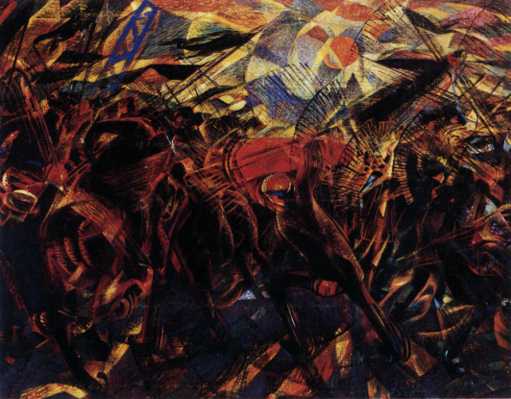 Carlo Carrà
Carlo Carrà  Carlo Carrà
Carlo Carrà Before the 19th century, painting was the art of silence. Painters of antiquity, of the Renaissance, of the 17th and 18th centuries, never envisaged the possibility of rendering sounds, noises and smells in painting, even when they chose flowers, stormy seas or wild skies as their subjects.
In their bold revolution, the Impressionists made some confused, hesitant attempts at sounds and noises in their pictures. Before them nothing, absolutely nothing!
However, we should point out at once that between the Impressionists’ swarming brush-strokes and our Futurist paintings of sounds, noises and smells there is an enormous difference, like the contrast between a misty winter morning and a sweltering summer afternoon, or to put it better, between the first signs of pregnancy and an adult man in his fully developed strength.
In the Impressionist canvases, sounds and noises are expressed in such a thin, faded way that they might have been perceived by the eardrum of a deaf man. This is not the place for a detailed account of the principles and experiments of the Impressionists. There is no need to enquire minutely into all the reasons why the Impressionists never succeeded in painting sounds, noises and smells. We shall only mention here what they would have had to drop to obtain results:
We Futurists therefore claim that in bringing the elements of sound, noise
and smell to painting we are opening fresh paths. We have already taught artists
to love our essentially dynamic modern life with its sounds, noises and smells,
thereby destroying the stupid passion for values which are solemn, academic,
serene, hieratic and mummified: everything purely intellectual, in fact. Imagination
without strings, words-in-freedom, the systematic use of onomatopoeia, antigraceful
music without rhythmic quadrature, and the art of noises— It is indisputably true that (1) silence is static and sounds, noises and smells
are dynamic; (2) sounds, noises and smells are nothing but different forms and
intensities of vibration; and (3) any succession of sounds, noises and smells
impresses on the mind an arabesque of form and color. We must measure this intensity
and perceive these arabesques.
These polyphonic and polyrhythmic abstract plastic wholes correspond to a requirement
of inner enharmonics that we Futurist painters believe to be indispensable to
pictorial sensibility.
These plastic wholes have a mysterious fascination and are more meaningful
than those created by our visual and tactile senses, being closer to our pure
plastic spirit.
We Futurist painters maintain that sounds noises and smells are incorporated
in the expression of lines, volumes and colors just as lines, volumes and colors
are incorporated in the architecture of a musical work. Our canvases will therefore
express the plastic equivalents of the sounds noises and smells found in theaters,
music-halls, cinemas, brothels, railway stations, ports, garages, hospitals,
workshops, etc., etc.
From the point of view of form: sounds, noises and smells can be concave,
convex triangular, ellipsoidal, oblong, conical, spherical, spiral, etc.
From the point of view of color: sounds, noises and smells can be yellow,
green, dark blue, light blue or purple. In railway stations and garages, and
throughout the mechanical and sporting world, sounds, noises and smells are
predominantly red; in restaurants and cafes they are silver, yellow and purple.
While the sounds, noises and smells of animals are yellow and blue, those of
a woman are green, blue and purple.
We do not exaggerate in claiming that smell alone is enough to create in our
minds arabesques of form and color which can constitute the motive and justify
the necessity of a painting. In fact, if we are shut in a dark room (so that
our sense of sight no longer functions) with flowers petrol or other strong-smelling
things, our plastic spirit gradually eliminates the memory sensations and constructs
particular plastic wholes whose quality of weight and movement corresponds perfectly
to the smells found in the room. These smells, through an obscure process, have
become an environment-force, determining that state of mind which for us Futurist
painters constitutes a pure plastic whole.
This bubbling and whirling of forms and lights composed of sounds, noises and
smells has been partly rendered by me in my Anarchist’s
Funeral and Jolts of a Taxi-cab by Boccioni in States of Mind
and Forces of a Street, by Russolo in Revolt and Severini in Pan
Pan, paintings which aroused violent controversy at our first Paris Exhibition
in 1912. This kind of bubbling over requires a powerful emotion, even delirium,
on the part of the artist, who in order to render a vortex must be a vortex
of sensation himself, a pictorial force and not a cold logical intellect.
This is the truth! In order to achieve this total painting, which requires
the active cooperation of all the senses, a painting which is a plastic state
of mind of the universal, you must paint, as drunkards sing and vomit, sounds,
noises and smells!
The painting of sounds, noises and smells rejects:
The painting of sounds, noises and smells calls for:
<< back